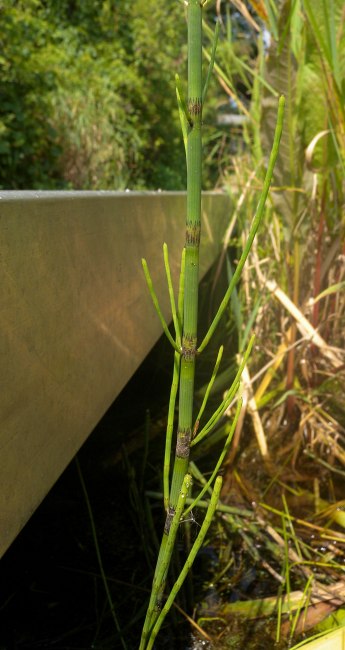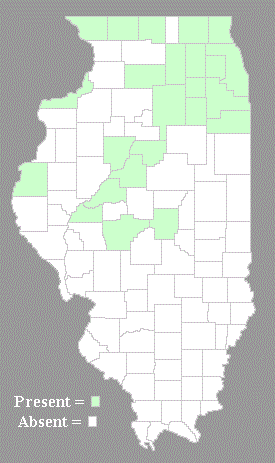
When jointed lateral branches occur, they are about 1–1.5 mm. in diameter; they are medium green, hairless, and terete with about 6 shallow furrows and rounded ridges. The first internodes of these branches (between the first pair of toothed sheaths) are usually shorter than the adjacent sheaths of the central stem. The interior of the central stem is largely hollow from a central cavity that extends to about 80% of the stem's diameter. There are also about 12 smaller cavities (called vallecular canals) that surround the large central cavity. Fertile stems terminate in solitary spore-bearing cones (strobili). These cones are ½–¾" (12.5–20 mm.) in length, ovoid in shape, and sessile to short-stalked (depending on their maturity). Each cone has several rows of sporangiophores (spore-bearing structures) that are slightly elevated and hexagonal in shape. Depending on their maturity, the cones can be greenish black, greenish white, black and white, or black. The sporangiophores are usually darker in color than the rest of the cone. The tip of the cone is rounded, but
 not apiculate (tapering
abruptly to a short narrow tip).
During the summer, the cones release their spores from the
sporangiophores. These tiny spores are distributed by the wind and
quite possibly by water. The root system is long-rhizomatous and
fibrous. Clonal colonies of plants are often produced from the
rhizomes. During the winter, the stems and any branches die down,
but new growth from the same root system occurs during the
spring.
not apiculate (tapering
abruptly to a short narrow tip).
During the summer, the cones release their spores from the
sporangiophores. These tiny spores are distributed by the wind and
quite possibly by water. The root system is long-rhizomatous and
fibrous. Clonal colonies of plants are often produced from the
rhizomes. During the winter, the stems and any branches die down,
but new growth from the same root system occurs during the
spring.Cultivation: The preference is full or partial sun, wet conditions (including shallow water), a substrate that contains some mud, sand, and/or organic material, and a boreal climate with cool to warm summer temperatures. This plant can spread aggressively from its rhizomes. It is very winter-hardy.
Range & Habitat: The native Water Horsetail (Equisetum fluviatile) is uncommon to occasional in the northern half of Illinois, while in the rest of the state it is rare or absent. Illinois lies along the southern range-limit of this species; it is more common in boreal areas that are north of Illinois. Water Horsetail occurs primarily in the upper Great Lakes of the Midwest, the New England area, and the Pacific Northwest of the United States; it also occurs as a native plant in many areas of Canada, central to northern Europe, and central to northern Asia. Water Horsetail occurs in a variety of wetland habitats; this includes cattail marshes, swamps, shrubby bogs, borders and shallow water of ponds, low areas along creeks, and ditches that often have standing water. Water Horsetail is typically found in higher quality wetland habitats in Illinois.
Faunal Associations: Various monophagous or oligophagous insects are known to feed on horsetails (Equisetum spp.). These species include the larvae of leaf-mining flies (some Liriomyza spp.), leaf beetles (Hippuriphila spp.), larvae of sawflies (some Dolerus spp.), Grypus equiseti (Horsetail Weevil), and Anoecia equiseti (an aphid). In North America, most of these species have been observed to feed on Field Horsetail (Equisetum arvense), while similar species in Europe have been observed to feed on Water Horsetail (Equisetum fluviatile) and other horsetails; see Poinar (2014) for more information. Among vertebrate animals, the stems of horsetails are eaten by the American Moose and Muskrat (Martin et al., 1951/1961). Colonies of Water Horsetail help to provide cover for various invertebrate and vertebrate animals, including wetland birds. Dragonflies sometimes use the apices of stems and cones as perching sites.
Photographic Location: Along the boardwalk of a cattail marsh at Volo Bog in Lake County, Illinois. The photographed plant is the form of Water Horsetail with lateral branches.

Comments: This horsetail has an attractive appearance and it is well-suited to various wetland habitats. While attempting to identify a horsetail species, it is important to keep in mind that Water Horsetail (Equisetum fluviatile) can be branchless or branched. Water Horsetail can be distinguished in part from other horsetails (Equisetum spp.) by its fondness for shallow water and very wet ground. The stems of Water Horsetail have the largest central cavities of any horsetail in Illinois. Its stems have a relatively smooth texture that is quite distinct from the rough stem texture of the common Scouring Rush (Equisetum hyemale affine) and some of its hybrids. The persistent teeth of Water Horsetail are entirely dark brown or nearly so, while the teeth of many other horsetails are more likely to break off, or they have conspicuous white margins. Water Horsetail can also be distinguished by its medium to large size (for a horsetail), the number of teeth on its sheaths, the number of ridges along its central stems, and the diameter of its central stems. The spore-bearing cones of Water Horsetail lack the narrowly pointed tip that occurs in several other horsetail species.